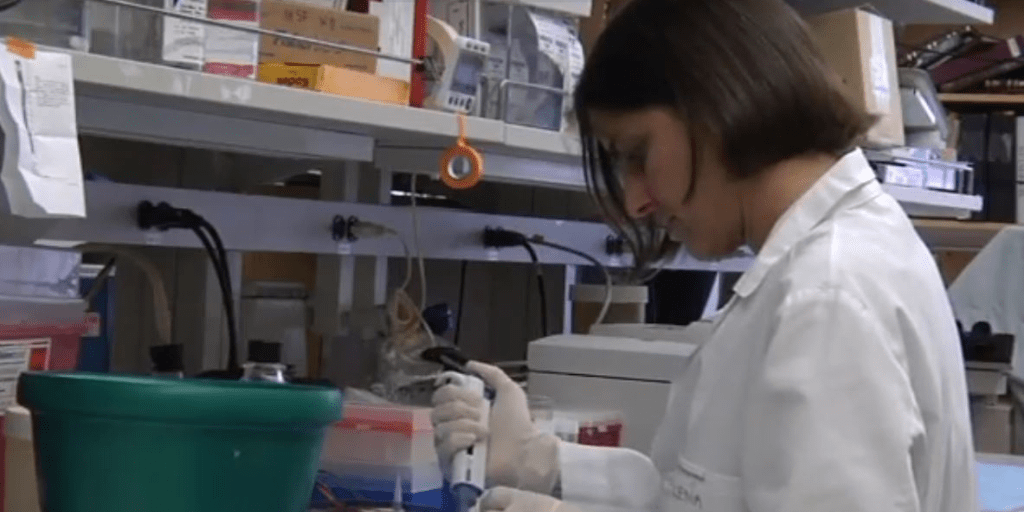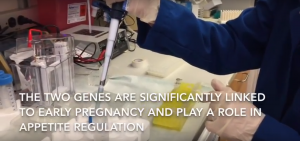Hyperemesis Gravidarum is not psychological and is not caused by hCG

The hormone Growth and Differentiation Factor 15 (GDF15) is the most likely cause of Hyperemesis Gravidarum (HG). GDF15 is made by the placenta and rises very rapidly early in pregnancy. It causes taste aversion, nausea, and vomiting. Read our groundbreaking studies on the genetics of HG, especially our studies in Nature.
Frequently Asked Questions
Read: New study in Nature
1. While we already knew GDF15 was involved in HG, we didn’t understand how it worked to cause HG. GDF15 is a hormone that causes nausea and vomiting and is produced by the placenta. The new study found that a main reason people get HG is because they make abnormally low levels of GDF15 prior to pregnancy and this makes them hypersensitive to the rise of GDF15 during pregnancy. This has exciting clinical implications for preventing HG by increasing GDF15 levels prior to pregnancy to desensitize patients, and conversely, treating HG by lowering the hormone during pregnancy.
2. Be patient. Clinical trials take time and must be done slowly and methodically. Know we are working very hard to test these methods as soon as we can and are as eager as you are to find answers.
Cause: Using genetics, the HER Foundation, led by Marlena Fejzo, PhD., found the cause of HG is related to the nausea and vomiting hormone GDF15. HG is not psychological and is not caused by hCG.
Read full article: www.nature.com/articles/s41467-018-03258-0
Both hormones, hCG and GDF15, rise rapidly and have peaks in the 1st trimester. Both cannot exist without genes to code for them. In contrast to GDF15, no variation in hCG genes have been identified that increase risk of HG. In addition, GDF15 directly causes nausea and vomiting. hCG does not.
GDF15 is a hormone that causes taste aversion, nausea and vomiting, not just during pregnancy, but also produced by organs under stress and by tumors. In cancer patients, it results in a condition called cancer cachexia which has similar symptoms to HG.
No. Although they do occur, GDF15 mutations in HG patients are rare. Most of the genetic changes we found associated with HG are small changes that increase risk of HG, but these changes must occur in combination with other factors.
The placenta makes GDF15 when people become pregnant. People with HG may have slightly different GDF15 sensitivity and levels than people with normal nausea and vomiting. We believe this difference makes them more likely to have HG.
Yes, we have found that in addition to GDF15, the genes that code for the progesterone receptor and IGFBP7 are also associated with risk of HG.
Related article: Live Science
We do not have a test yet. Getting FDA approval is a long process and this is just the beginning. We still have a lot to learn. Having the 2 variants that were confirmed in the paper increases the risk of having HG. It does not mean that if you have these variations in your DNA you will have HG and vise versa. And, it does not mean that if you do NOT have them, you will NOT get HG. There is still a lot of work we need to do to understand the genetic component, but this provides a very promising starting point. There are also other genetic risk factors that the study pointed to that we did not have funding to confirm, so this is not the end of the story. It is a new beginning.
Related article: 23andme
This study provides scientific evidence linking 2 genes, GDF15 and IGFBP7, to HG. These genes provide the instructions to build the proteins GDF15 and IGFBP7 in the human placenta during pregnancy. The proteins are known to be important in the development of the placenta and in controlling appetite. We have done additional work presented at the ICHG (vimeo.com/260389622) showing that not only are these genes linked to HG, but also, the proteins are abnormally high in the blood from patients hospitalized with HG. This suggests that the DNA instructions in some HG patients are telling the placenta to make too much GDF15 and IGFBP7 protein, which then gets into the mother’s blood, and causes extreme nausea and vomiting. This information provides strong evidence that these proteins are directly involved in causing HG. It puts an end to the unfortunate misogynistic nonsense that HG is “all in your head.”
This suggests that the DNA instructions in some HG patients are telling the placenta to make too much GDF15 and IGFBP7 protein, which then gets into the mother’s blood, and causes extreme nausea and vomiting. This information provides strong evidence that these proteins are directly involved in causing HG. It puts an end to the unfortunate misogynistic nonsense that HG is “all in your head.”
Read full article: www.nature.com/articles/s41467-018-03258-0
The study did not only look at HG. It also looked at different levels of nausea and vomiting from none, slight, moderate, severe, and very severe (HG). The study suggests that the same genes, GDF15 and IGFBP7, involved in HG are also involved in normal nausea and vomiting. Basically if you have these genetic variations that are linked to HG, you are more likely to have normal nausea and vomiting than no nausea and vomiting, and more likely to have HG than normal nausea and vomiting. Basically having the genes increases your risk, but ultimately it is likely the level of the proteins that is causal, which may vary depending on the genes and other factors that we still do not understand.
Related article: Genomeweb
Related article: Familial Link of HG
We now have evidence that HG is caused by a combination of genetics and other factors. The greatest genetic risk factor for HG is variation in a gene that codes for the placenta and appetite hormone GDF15. Other genes are also associated with HG including a gene, GFRAL, that codes for the receptor of GDF15 in the vomiting center of the brain, the progesterone receptor PGR, and another placenta and appetite gene, IGFBP7. You inherit one copy of each of these genes from your biological mother and one copy from your biological father. You may not see HG in your family even if you have inherited the genes because you may have inherited them from your father, or you may need to inherit a combination of the genes mentioned above in order to get HG. Your mother may pass on one part of the combination, and your father the other.
In addition, there are other things besides genes that may contribute to HG. For example, we know that abnormal levels of GDF15 cause nausea, vomiting, and weight loss. But genetics is not the only factor that can increase GDF15 levels. We now know that other things also cause your body to produce more GDF15 hormone including nutrient deprivation, hyperthyroidism, potassium depletion, and infection. We still have a lot to learn, but for now we believe, abnormal levels of the GDF15 hormone play a big role regardless of whether the abnormal levels come from inheriting gene(s) from your mom, dad, both and/or from other factors.
Related article: Science Daily
We know that about 80% of women will have a recurrence, and we now have the first clues as to what is going on in those lucky 20%. Our new study in Nature suggests:
- If you have a GDF15 lowering mutation and your baby inherits it, then that may decrease the risk of an HG pregnancy, while if your baby does not inherit it, then you may have HG again. However, this study was very small, so more work is needed to confirm this. But the new study suggests both mother and baby may be contributing to the risk of getting HG, which can explain why it does not always occur in every pregnancy.
- HG is caused by a mom’s hypersensitivity to the hormone GDF15 which rises in early pregnancy.
- A mom can be hypersensitive to the GDF15 hormone if she has abnormally low levels of it in her blood before pregnancy. She may be predisposed to having lower levels before pregnancy if she has the GDF15 genetic variants that result in lower levels. But there are also environmental factors that can alter GDF15 levels.
We need to make sure the findings are generalizable to people of different ancestries and whether certain combinations of genes increase risk.
So far, we have found that there are abnormal levels of GDF15 and IGFBP7 in the blood of women hospitalized with HG. We have more work to do to understand how common this is for HG patients and what the cut-off levels are for HG versus normal nausea and vomiting in the blood of pregnant women. Eventually this could lead to a test similar to a pregnancy test. This will take time.
Related article: Recurrence Risk HG
Related article: 23andme
Cachexia is a condition characterized by the same symptoms as HG, nausea and vomiting, weight loss, muscle wasting, and extreme debility. Cachexia is the cause of death in 20% of cancer patients. Until now, we did not know that HG and cachexia are biologically related. This is very good for HG because while research and investment in HG is minimal, there is a lot of interest in developing treatments for cachexia. A mouse model of cancer cachexia treated with a drug blocking GDF15 has already shown great promise. The drug restored appetite and weight gain in the mouse. If this drug is safe in pregnancy, it could be a very promising strategy for treating HG.
Related article: Live Science
These findings provide the most promising avenue to date for developing a treatment for HG. Now that we know GDF15 and IGFBP7 are involved, we can start thinking about what might be the best way to lower the levels of these factors in HG patients. Of particular interest, a drug blocking GDF15 has successfully restored appetite and weight gain in a mouse model with abnormally high levels of GDF15, so if it is safe in pregnancy, this holds much promise for HG. But I would like to caution that making and testing a drug for pregnant women is a very long and difficult process, so knowing whether this strategy will be successful is a long way off.
Related article: Science Daily





